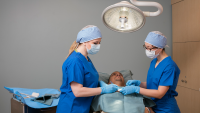Mohs Surgery
A highly effective treatment for some types of skin cancer
Make an Appointment
Our team is here to help you make an appointment with the specialists that you need.

Of all the treatments for skin cancer, Mohs micrographic surgery offers the highest cure rate (up to 99%) and the lowest chance for regrowth. It minimizes the potential for scarring and is the most exact and precise method currently available for removing skin cancer. It is a highly effective treatment for skin cancers with aggressive behavior or located in cosmetically sensitive areas.
Mohs surgery is named after Frederic E. Mohs, MD, who first developed the procedure as a medical student at the University of Wisconsin in the 1930s. Also known as "microscopically controlled surgery," Mohs combines the surgical removal of skin cancer with an immediate microscopic examination. This technique allows 100% of the area around and under the skin cancer to be examined microscopically to make certain that all of the roots have been removed. It is the only technique available that ensures that all of the skin cancer is removed while sparing normal, healthy tissue to the greatest degree possible.
Mohs surgery is frequently used to remove basal cell carcinomas and squamous cell carcinomas, the two most common skin cancers. Mohs surgeons are dermatologists who have completed fellowship training in Mohs surgery and are highly skilled in both surgical technique and tissue examination, as well as in reconstructive surgery of the skin.
Outpatient Surgery in Stages
Mohs surgery is an outpatient procedure that is very similar to other types of skin surgery. Mohs is different from other skin surgeries in that it takes place in several stages, with tissue examination occurring between each stage, while other types of skin surgery are performed all at one time.
When you arrive for surgery, the area of skin that needs to be removed will be numbed using a local anesthetic. Once the skin is numb, the abnormal area will be removed using a scalpel. In this first stage of surgery, only the area that appears to be abnormal is removed. It takes only a few minutes to complete the surgery, after which the area is bandaged and the tissue is sent for processing. You will remain in the surgical area or return to the patient lounge during the processing, which can take up to an hour.
The ability to process and examine your tissue while you are still available is what makes Mohs unique. Tissue processing takes 20 to 30 minutes (or more if the section is large), after which it is examined under a microscope. The examination focuses on the outer edge of the sample: If there is cancer on the outer edge, it can be assumed that there is still some skin cancer at the excision site.
If there is still skin cancer remaining at the excision site, we will re-numb your skin and repeat the surgical procedure. Because Mohs is so precise, we can use the technique to remove only the affected area and preserve your healthy skin. With each stage of Mohs surgery, we are looking for the roots of the cancer and removing them, until the cancer is completely removed and won't grow back.
The process of surgical removal and examination of the tissue sample is repeated until there is no skin cancer remaining in the area. Each pass of surgery and examination is called a "stage". It takes an average of two to three stages to remove all of the cancer – the number of stages for your particular surgery can't be determined until the surgery is in process.
Reconstructive Surgery
Once the surgery is complete, your surgical wound will either be closed with stitches or left to heal on its own, depending on its size and location. Most reconstructive surgery can take place on the day of your Mohs surgery and will involve closing the wound with a skin flap (shifting nearby tissue) or a skin graft (taking skin from another area of the body). You will be provided with detailed instructions for the care of your wound.